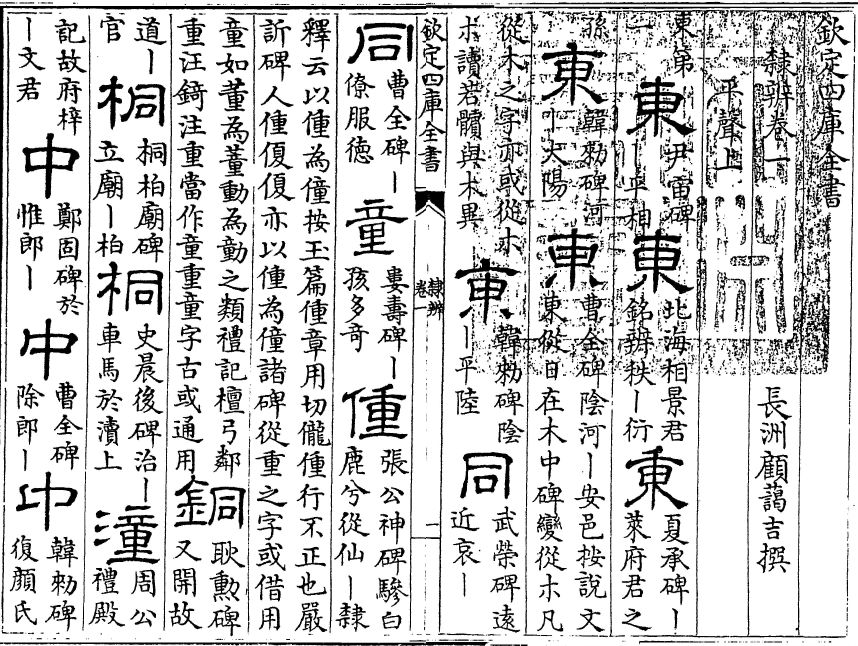Libian 隸辨 "About the chancery script" is a book on Chinese characters written during the Qing period 清 (1644-1911) by Gu Aiji 顧藹吉 (fl. 1708), courtesy name Wanxian 畹先, style Tianshan 天山 or Nanyuan 南原.
Gu hailed from Changzhou 長洲 (modern Wuxian 吳縣, Jiangsu) and was, as a "tributary student" (gongsheng 貢生), compiler (zuanxiuguan 纂修官) of notes on calligraphy and paintings, then educational instructor (jiaoyu 教諭) in Yizheng 儀征. Gu Aiji was a famous landscape painter and a master in the bafen 八分 writing style.
His 8-juan-long book was written out of the need to precisely determine the meaning of characters of the chancery script (lishu 隸書), in which the transmitted versions of the Confucian Classics were written, and which was later transformed into the "modern" standard script (kaishu 楷書). With the change of the shape of characters, some lost their meaning, especially from the Tang period 唐 (618-907) on, when the standard script became more "vernacularised" (suzi 俗字).
Gu's book is the result of long decades of study. It was based on an earlier book, Lou Ji's 婁機 (1133-1211) Han lizi yuan 漢隸字原 from the Southern Song period 南宋 (1127-1279), which made use of Han-period 漢 (206 BCE-220 CE) stone inscriptions to go back to the "original" shape of characters. Other sources are the studies Lishi 隸釋 or Lixu 隸續 of Hong Shi 洪適 (1117-1184).
 |
The text is arranged according to a rhyme system, beginning with the rhyme group 東 /tuŋ/. The first lemma presents different writings of the character 東 "east", namely the inscription of the stone slab of Yin Zhou 尹宙碑 (「東平相」), the inscription Beihai xiang jing jun ming 北海相景君銘 (「辨秩東衍」), the inscription of Xia Cheng 夏承碑 (「東衍萊府君之孫」), the slab of Han Lai 韓勑碑 (「河東大陽」), the famous stone of Cao Quan 曹全碑 (「陰河東安邑」), and a second reference to the slab of Han Lai (「陰東平陸」). The inscription of the Cao Quan slab is annotated: Even if the classical dictionary Shuowen jiezi 說文解字 says that the character 東 is derived from the character 日 "sun" inside that of 木 "tree, stone slab inscriptions use to write the word (and other words with the component 木) with the component pin 朩 instead, which is actually read like 髕 /bǐěn/. Siku quanshu 四庫全書 edition. |
The words in the Libian are arranged according to the rhyme system established in the dictionary Libu yunlüe 禮部韻略. For each entry, examples from stone inscriptions are provided, and erroneous statements in the Han lizi yuan are adjusted. The Libian points out many errors in the distinction of characters (like 舩 and 船, 爯 and 再, 血 and 皿, or 朋 and 多).
Gu Aiji discusses the correct, altered, abbreviated or enlarged shape of characters. In juan 6, the book explains the change of the shape of characters from seal script to chancery script. Juan 7 and 8 (Beikao 碑考) provide information about the identity and location of inscribed stone slabs. The compilers of the descriptive bibliography Siku quanshu zongmu tiyao 四庫全書總目提要 doubt that Gu Aiji can have personally inspected all quoted stone inscriptions, and highlight some erroneous quotations. His book is nevertheless an essential source for the history of the Chinese script, and is therefore included in the imperial series Siku quanshu 四庫全書.